
Apples from the Isle of Wight
The experts in "Isle of Wight" apples are Deacons of Deacon's Nursery, Godshill, I.O.W. Their website is at
www.deaconsnurseryfruits.co.uk .
I've listed below some of the varieties associated with the Isle of Wight, in approximate fruiting order, early to late. Many of these have been
discovered and introduced by Deacon's Nursery, which is now celebrating its fortieth anniversary. Their
catalogue is better than many textbooks on fruit, and is
fascinating, even if you don't want to buy any trees. If you ask for one, it would be a good gesture
to send £1.50 ($3) plus postage - they are
expensive to print.
Deacon's Millenium:
Pillar box red apple with lots of bloom; excellent show apple. Introduced for the
millenium. White fleshed with slightly sub-acid flavour. Ready for picking early September, juicy; best eaten
straight off the tree. Will keep for a short while. Late summer dessert apple.
Peter's Pippin:
Deacon seedling from open pollinated Granny Smith. Cox-like flavour, gold and red, with some
russeting. Larger than Cox. Late summer dessert apple.
Vickey's Delight:
Seedling raised locally; late summer dessert apple. Very early; in season at same time as
Beauty of Bath. Needs eating straight from the tree.
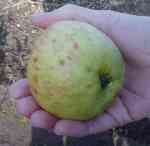
Ernie's Russet:
Early autumn dessert apple, large colourful russet found in
an Isle of Wight garden. Picture below.
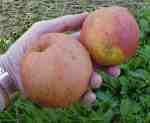
Nettlestone Pippin:
Early autumn dessert apple. Seedling from a cross between James Grieve and Cox's Orange Pippin. Very attractive apple,
ready mid-September. Cox size, brightly striped red and gold, with the James grieve shape. Quite juicy, slight
russeting. Skin is shiny and slightly waxy. Ideally eaten from the tree. Typically stores until end-Oct.
Peter's Seedling:
Early autumn dessert apple. Sister seedling of Peter's Pippin. Good size for kids; no waste, profuse cropping, pick
late in August. Fruit is small and red all over.
Sandlands:
Apple produced by a customer of Deacon's and a local horticultural judge. Prolific fruiting mid-sized fruit of
very good flavour. Quite juicy; good keeping qualities. Early autumn dessert apple. Picture
below.
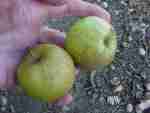 .....
.....
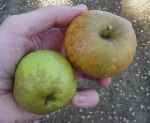
Bembridge Beauty:
New variety named by a customer of Deacon's; late autumn dessert apple. Juicy, average sized
Worcester-type fruit.
Deacon's Blushing Beauty:
Originated Godshill; fruit is bright yellow with a distinctive pink flush on the sunny side. Dual-purpose, cooking
well and later being extremely palatable, with a slightly sub-acid flavour and profusely juicy. Ready
end-Sept/early Oct. Irregular shape, but similar to Greensleeves, with pink face. Late autumn dessert.
Anniversary:
Mid-winter dessert apple, all over red, crisp and juicy. Picked late September will last through the winter, often until
February. Looks as though it may have show bench potential.
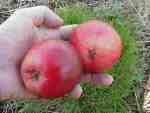
Evening Gold:
Mid-winter variety. Believed locally to be an island apple. Keeps well into February. Apple is like the setting sun - golden with
bright orange flush. Retains good flavour even at end of storage time. Very hardy - even windfalls will store. For
those with a sweet tooth. Probably best described as dual purpose; fruit is medium sized.
Isle of Wight Russet:
Mid-winter dessert apple. A really large russet, but without an abundance of russeting. Sweet and juicy; very even-cropping.
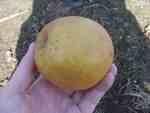
Sir John Thorneycroft:
Mid-winter dessert apple raised by Sir John's head gardener in Bembridge, I.O.W. in 1911. Received order of merit in 1911 and introduced by S.Bunyard in 1913. Crisp and juicy.
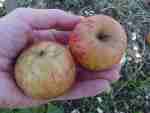
Isle of Wight Pippin
Spring dessert apple. Should be left as long as possible on the tree. Will ripen Dec-Jan; stores at least until March.
Introduced to the island from Normandy in 1817, but much earlier in origin. Smallish flat fruit. Skin is yellow
with orange flush, with some russeting. Flesh is tinged green, with slightly sweet flavour. Good bouquet. Early flowering, but
maturing late. Very resistant to canker and mildew. Picture below.
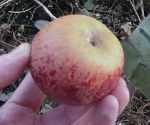
Steyne Seedling:
Spring dessert apple, as above. Another seedling raised by Sir John Thorneycroft of Bembridge in 1893. Very
intense flavour, similar to Cox. Soft cream flesh. A popular choice.
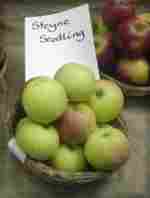
Golden Glow:
Deacon's new cooker; prolific fruiting, even in bad years. Early to mid season; medium sized fruit.
Howgate Wonder:
Late keeping cooking apple; in Guinness Book of Records as largest apple. Large red striped fruit, cropping well
and regularly, with neat compact growth. Good for baking. Fruit is sweet and juicy and keeps its shape when cooked.
Another good pollinator for Bramley. Raised by G.Wratten, Howgate Lane, Bembridge, I.O.W. in 1915.
 ..........................
..........................

Mary's Apple:
Developed and grown by a lady who lived close to Osborne House, East Cowes, I.O.W. This excellent apple is
late-keeping, and every year produces prolific crops of large green dual purpose fruit. A strong grower.
Sunnydale:
A local discovery. Very very late cooker, staying on the tree until February (a bit like Leicestershire's Whitwick Pippin - N.D.).
Codlin type. Dessert quality later.
Information on the apples reproduced
by kind permission of Graham Deacon, nurseryman, Godshill.
Nigel Deacon, Diversity website